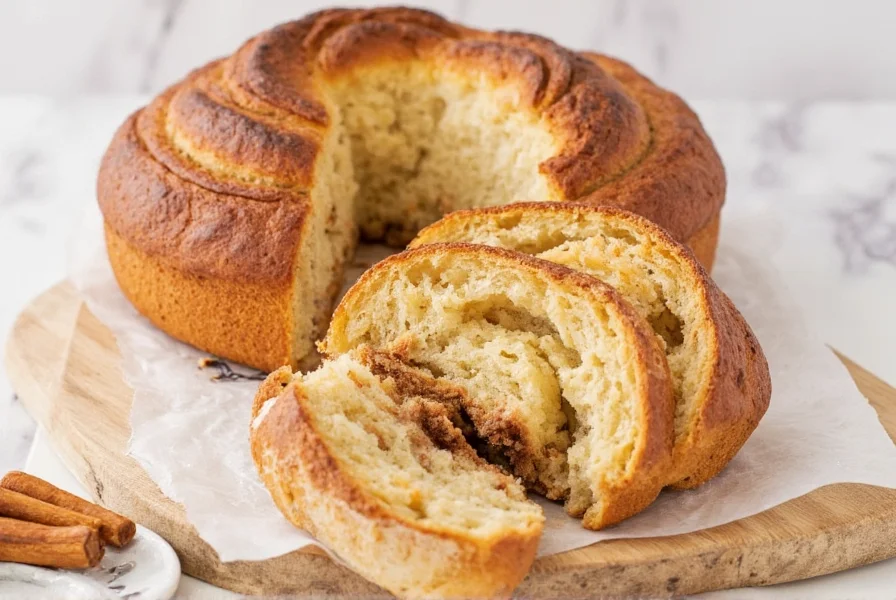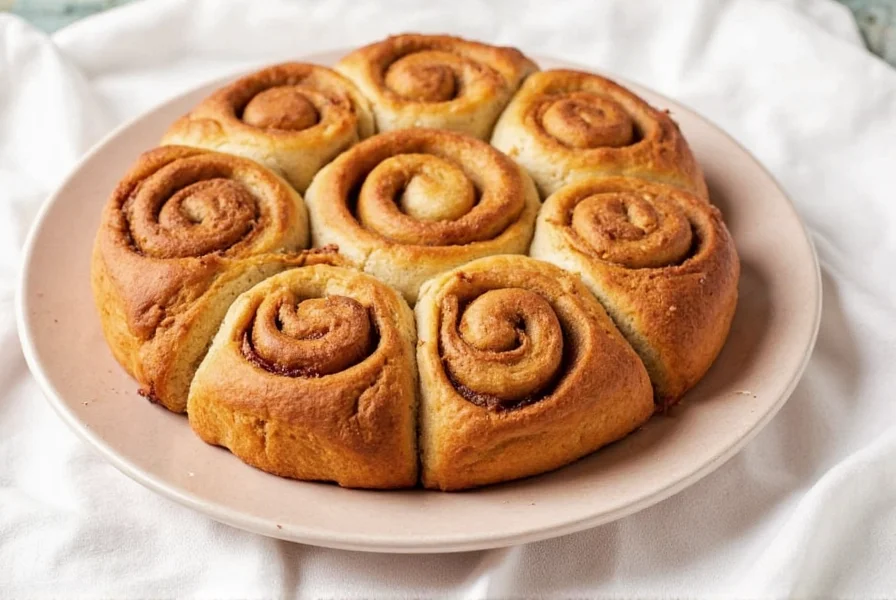What Exactly Is Cinnamon Roll Bread?
Cinnamon roll bread represents a clever adaptation of the classic pastry, transforming it into a loaf-style baked good that maintains all the beloved characteristics while offering practical advantages. This innovative approach to cinnamon rolls creates a product that bridges the gap between sweet breakfast pastry and artisan bread.
The fundamental difference between cinnamon roll bread and traditional cinnamon rolls lies in the baking method and final presentation. While conventional cinnamon rolls are cut into individual spirals before baking, cinnamon roll bread maintains its integrity as a single loaf. This structural difference affects not only the appearance but also the texture and serving experience.

Essential Ingredients for Perfect Cinnamon Roll Bread
Creating exceptional cinnamon roll bread requires attention to ingredient quality and proper ratios. The foundation consists of standard bread ingredients enhanced with the signature cinnamon-sugar filling that defines this specialty item.
| Ingredient Category | Key Components | Professional Tips |
|---|---|---|
| Dough Base | All-purpose flour, yeast, milk, sugar, butter, eggs | Use lukewarm milk (105-110°F) to activate yeast without killing it |
| Cinnamon Filling | Brown sugar, ground cinnamon, melted butter, optional nuts | Mix cinnamon with sugar first to prevent clumping in the filling |
| Glaze | Powdered sugar, milk, vanilla extract, optional cream cheese | Add glaze only after bread has cooled completely to prevent melting |
Step-by-Step Baking Process
Mastering the technique for cinnamon roll bread requires understanding several critical stages. The process begins with proper dough preparation, which sets the foundation for the entire recipe.
Start by activating your yeast in warm milk with a small amount of sugar. While the yeast proofs, prepare your dry ingredients in a separate bowl. The ideal dough should be smooth and slightly tacky but not sticky. Kneading time typically ranges from 8-10 minutes by hand or 5-7 minutes using a stand mixer with dough hook attachment.
After the first rise (approximately 1-1.5 hours at room temperature), roll the dough into a large rectangle about ¼ inch thick. This thickness is crucial for achieving the perfect cinnamon roll bread texture—too thick and the filling won't distribute properly, too thin and the dough may tear.
Spread softened butter evenly across the rolled dough, then generously sprinkle your cinnamon-sugar mixture. For optimal results when making cinnamon roll bread from scratch, use a 4:1 ratio of brown sugar to cinnamon. Roll the dough tightly from the long edge, pinching the seam to seal.
Place the rolled dough seam-side down in a greased loaf pan. The second rise should take about 30-45 minutes until the dough has noticeably expanded. Bake at 350°F for 30-35 minutes, or until golden brown and an internal thermometer reads 190°F.
Pro Techniques for Bakery-Quality Results
Professional bakers employ several specialized techniques when preparing cinnamon roll bread that home cooks can easily adopt. Temperature control represents one of the most critical factors in achieving consistent results with this delicate recipe.
Maintain your kitchen environment between 70-75°F during rising periods. Extreme temperatures can cause uneven rising or yeast death. For the most reliable cinnamon roll bread technique, use a digital thermometer to verify milk temperature before mixing with yeast.
When spreading the filling, work quickly to prevent the butter from cooling and solidifying. If you're making cinnamon roll pull apart bread, consider adding a thin layer of chopped pecans or walnuts between the cinnamon-sugar layers for added texture and flavor complexity.
One professional secret for preventing filling leakage during baking involves creating a small border of plain dough around the edges of your rolled rectangle before adding the filling. This creates a natural seal that contains the sweet mixture during baking.
Variations and Dietary Adaptations
Cinnamon roll bread offers remarkable versatility for different dietary needs and flavor preferences. Many home bakers successfully create gluten-free versions using quality gluten-free flour blends with xanthan gum already incorporated.
For dairy-free adaptations, substitute plant-based milk and coconut oil for traditional dairy ingredients. Vegan cinnamon roll bread works well when replacing eggs with flax eggs (1 tablespoon ground flaxseed mixed with 3 tablespoons water per egg).
Consider these popular flavor variations for your cinnamon sugar bread loaf recipe:
- Apple cinnamon roll bread with diced apples folded into the filling
- Caramel pecan version with homemade caramel sauce drizzled over the filling
- Orange zest variation for a bright citrus note that complements the cinnamon
- Double cinnamon approach using both ground cinnamon and cinnamon extract
Storage and Serving Recommendations
Proper storage techniques significantly impact the shelf life and quality of your cinnamon roll bread. For optimal freshness, store cooled bread in an airtight container at room temperature for up to 3 days.
When considering cinnamon roll bread storage tips, remember that refrigeration actually accelerates staling in yeast breads. For longer storage, wrap individual slices tightly in plastic wrap and freeze for up to 3 months. Thaw at room temperature or gently warm in a 300°F oven for 5-7 minutes.
Serve cinnamon roll bread slightly warmed for the best texture and aroma. The ideal serving temperature is approximately 90-100°F, which allows the cinnamon flavors to fully express themselves while maintaining structural integrity.
Troubleshooting Common Issues
Even experienced bakers encounter challenges with cinnamon roll bread. Understanding these common problems and their solutions will help you perfect your technique.
Dense texture: This typically results from over-flouring the dough or insufficient rising time. Measure flour using the spoon-and-level method rather than scooping directly from the bag. Ensure your yeast is fresh and active by testing it in warm liquid before incorporating into the recipe.
Filling leakage: If your cinnamon sugar mixture leaks during baking, you likely rolled the dough too tightly or didn't create proper seals at the edges. Try reducing the amount of filling slightly and ensuring the dough edges are well-sealed before the second rise.
Uneven browning: Rotate the loaf pan halfway through baking to ensure even exposure to heat. If the top browns too quickly, tent with aluminum foil for the remaining baking time.
Final Thoughts
Cinnamon roll bread represents the perfect marriage of two beloved baked goods, offering the rich flavor of traditional cinnamon rolls with the convenience of bread format. By following these detailed instructions and incorporating the professional techniques outlined, you'll consistently produce bakery-quality results that impress family and friends.
Remember that practice improves results with this recipe—each batch helps you refine your cinnamon roll bread technique. Don't be discouraged by initial imperfections, as even "less than perfect" cinnamon roll bread remains delicious and satisfying.
Frequently Asked Questions
Can I prepare cinnamon roll bread the night before baking?
Yes, you can prepare cinnamon roll bread dough the night before. After shaping the loaf and placing it in the pan, cover it tightly and refrigerate for up to 18 hours. When ready to bake, remove from refrigerator and allow to come to room temperature while the oven preheats, which typically takes 1-1.5 hours.
Why does my cinnamon roll bread collapse after baking?
Collapse after baking usually indicates underbaking or insufficient structure. Ensure your bread reaches an internal temperature of 190°F before removing from the oven. Additionally, avoid opening the oven door during the first 25 minutes of baking, as temperature fluctuations can cause collapse. Using the proper flour with adequate protein content (11-12%) also provides necessary structure.
How can I make my cinnamon roll bread more moist?
To enhance moisture in cinnamon roll bread, consider adding 2-3 tablespoons of sour cream or plain yogurt to the dough. You can also brush the warm bread with a simple syrup (equal parts sugar and water, heated until dissolved) immediately after baking. Proper storage in an airtight container prevents moisture loss during storage.
Can I use instant yeast instead of active dry yeast?
Yes, you can substitute instant yeast for active dry yeast in a 1:1 ratio. The primary difference is that instant yeast can be mixed directly with dry ingredients without proofing in liquid first. If using instant yeast in your cinnamon roll bread recipe, you may notice slightly faster rising times, so monitor the dough carefully during proofing stages.











 浙公网安备
33010002000092号
浙公网安备
33010002000092号 浙B2-20120091-4
浙B2-20120091-4